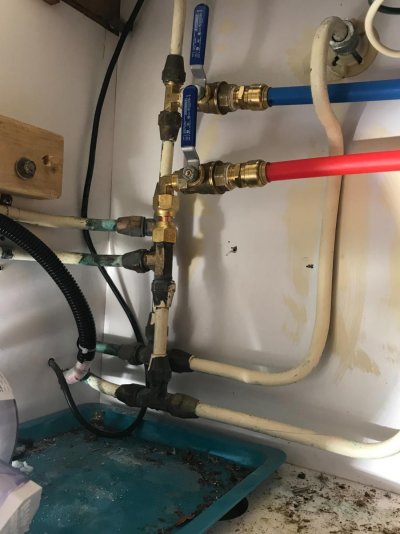There's LOTS of lead in older residential plumbing, 50/50 solder was the norm until about the late 80's when lead free solder was pushed into the market. Brass sweat fittings were very common, as well as brass fixtures, valves, etc. Ubiquitous. Old water system infrastructure contains lead (100% lead pipe) water services, many of which are still in use today in older cities. Lead pipe can last a LONG, LONG time.
California started sounding the alarms with all the stuff known to the state of California to be out to kill you, so all that old plumbing became very bad for your health. That concern has merit, but the concern was always with extended contact and exposure over a long period of time (lifetime). Still, it's been concluded that no amount of lead exposure is acceptable, so the elimination of lead components in domestic plumbing was a logical way to reduce exposure.
So you won't drink the water from your boat's system, but you'll happily glug down water from those plastic bottles you have to purchase and schlepp aboard. The materials those bottles are made from are deemed by the EPA to be safe. By today's standards. Who controls the purity of the bottled product? Before you condemn your boat's system as poisonous, keep in mind that the fittings in the system that contain trace amounts of lead have accumulated an oxide coating over the years that inhibits the leaching of lead. Lead leaching is a function of contact time, so running a bit of water will flush the leachate. Chances are, your residential plumbing, unless your home is less than 30 yrs old, probably has the same or higher potential for lead exposure than your boat does. Do you drink the water at home? If you're really concerned about lead exposure with the boat's system, have the water tested for lead. You can then make an informed decision regarding its potability.
WRT the plastic bottles, while they're currently a "safe" alternative, who knows what future science may reveal about health hazards connected with the poly that creates PEX or of those ubiquitous bottles. As far as their disposal, one needs only to take a short walk on any beach to assess their environmental impact. Recycling is proving to be problematic.
With my plumbing background, I've always found it puzzling that some of the boating community seems to eschew the water carried on board under conditions which they directly control, in favor of water in plastic bottles; a product they must purchase, transport, store, dispose of the packaging, and have no control over the quality. There's no marketing for tank water, but I'd be surprised if there's a significant quality difference. Chalk it up to personal preference. Test it.



